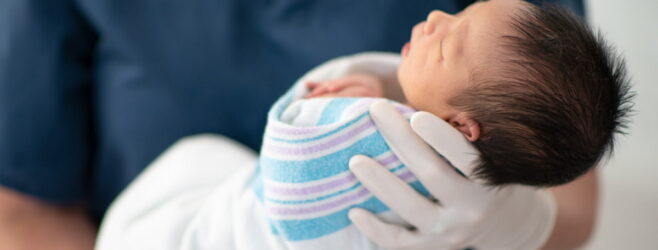During delivery, shoulder dystocia can be a serious complication for both mother and child. It occurs when one of the baby’s shoulders is stuck behind the mother’s pubic bone or sacrum (the bone at the back of the pelvis).
If the medical team can’t get the baby out in time, the baby may asphyxiate (be deprived of oxygen) or suffer other severe injuries. Shoulder dystocia complications can result in Erb’s palsy and other conditions that will change the child’s life forever.
One Israeli doctor, concerned about the overwhelming 1.5 million cases of shoulder dystocia worldwide, developed a simple device — the Yaari Extractor — to help release a baby’s shoulders and prevent permanent birth injuries.
Did your child experience an injury after shoulder dystocia complications? Contact us now to see how we can help find resources for you and your family.
What Are Shoulder Dystocia Complications?
Shoulder dystocia is a dangerous condition that could result in serious birth injuries or even death of the child.
One family in the state of Georgia filed a lawsuit in August 2023 after the tragic death of their child due to delivery staff using excessive force during shoulder dystocia complications.
If handled improperly, it can lead to life-long complications caused by birth injuries, including:
- Clavicular fracture: The baby’s clavicle or collarbone could be fractured due to shoulder dystocia and the force used to extract the baby.
- Erb’s palsy: Erb’s palsy, also called brachial plexus palsy, is a type of arm paralysis caused by injury to the nerves that signal movement for the arm, shoulder, and hand. Each year, about 50,000 babies experience brachial plexus injury after maneuvers to release them from shoulder dystocia.
- Hypoxic-ischemic encephalopathy (HIE): HIE is a type of brain damage caused by a lack of oxygen shortly after, during, or before birth. Babies who experience HIE may develop permanent disabilities such as cerebral palsy.
However, the new Yaari Extractor could work to prevent these conditions by quickly and easily turning the baby within the canal without causing any injury to the mother or baby.
The Yaari Extractor & Shoulder Dystocia
The Yaari Extractor was created by Dr. Abraham Yaari, an obstetrician-gynecologist (OB/GYN) with decades of medical experience, and medical device entrepreneur Aaron Feldman.
After talking to other professionals about shoulder dystocia and the problems it can cause, Dr. Yaari and Mr. Feldman launched FetalEase, the medical device startup that developed the Yaari Extractor.
The Yaari Extractor will be the first device to specifically resolve shoulder dystocia if it passes all clinical research studies.
How the Medical Device Will Release a Baby’s Stuck Shoulders at Birth
The Yaari Extractor has a flexible silicone sheath between two control arms. The physician can use the control arms to slowly position the sheath into the mother’s birth canal and around the baby’s shoulder.
They then turn the device slightly to free the baby’s shoulder from the mother’s pubic bone. The mother can then continue pushing the baby out naturally.
So far, the Yaari Extractor seems to be much safer than the current shoulder dystocia maneuvers used to shift babies until the shoulders are free. The device remarkably puts no pressure on the baby’s head or neck. In a birth simulator test, the pressure exerted on the mother was far less than other extraction maneuvers.
In 2022, a doctor in India used the device to deliver a 10-pound baby with shoulder dystocia. The doctor reported that both the baby and mother completed delivery without any injuries.
How Could the Yaari Extractor Affect Shoulder Dystocia Birth Injuries?
The Yaari Extractor can decrease the risk of shoulder dystocia birth injuries by freeing the baby’s shoulders before the baby suffers an injury from being trapped in the birth canal.
In other words, the Yaari Extractor could lead to:
- Fewer babies lost to asphyxiation
- Fewer babies who develop life-long disabilities due to asphyxiation and other shoulder dystocia-related injuries
- Fewer severe long-term injuries
Despite the promising early study results, obstetricians continue to test the risks and effectiveness of the device. In fact, the Food and Drug Administration (FDA) approved the Yaari Extractor for clinical trials, which will begin this fall 2023.
Dr. Yaari and Aaron Feldman hope their device may be approved for widespread use in 2025 if the initial trials go well.
Help Is Available for Shoulder Dystocia Birth Injury Victims
Shoulder dystocia birth injuries can be costly to treat, especially if the injuries lead to lifelong consequences such as Erb’s palsy and cerebral palsy. Fortunately, birth injury victims and their families are able to seek help through legal resources.
By filing a birth injury lawsuit, families may be able to recover compensation and hold responsible parties, such as obstetricians, nurses, and hospitals that failed to identify and treat shoulder dystocia in time, accountable.
See how the Birth Injury Justice Center can help you by starting a free case review now or calling our advocates at (800) 914-1562.



